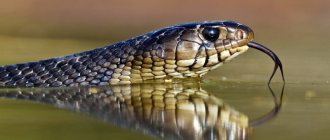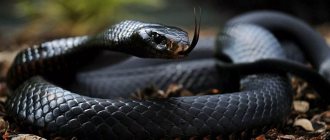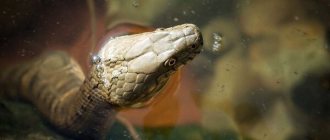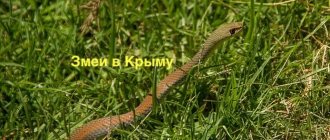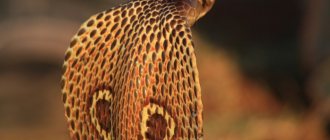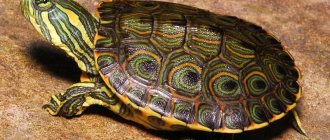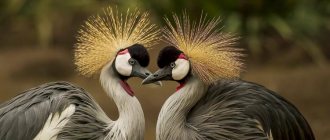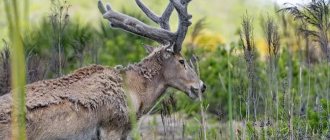Snakes are incredibly beautiful and elegant reptiles. They are not capable of emotional communication with a person, and they do not experience trembling feelings at the sight of the “master”. However, there are many people who are ready to keep snakes at home - solely for the sake of experiencing aesthetic pleasure from these creatures.
Snakes are, of course, not only beautiful, but also very dangerous. Every year, about 100 thousand people die from bites of these graceful reptiles, half of which occur in India. But among snakes there are also quite friendly species - some of them even like to be in a person’s arms!
In our selection you can see the most beautiful snakes on the planet. Indeed, their grace and beauty are best admired from a distance.
Baird's rat snake
A very beautiful chameleon snake.
On pebbles and sand it has a reddish-rusty color, and on the ground it becomes steel-colored, the scales cast as polished metal. Red tide
Changes color
Metal shimmer
King Cobra
The largest snake on the planet, the king cobra can reach 6 meters in length. This is the only snake known to mankind that can feed on its relatives, including poisonous ones.
Unlike other snakes, the king cobra knows how to control the amount of poison it releases - often, it bites people without any poison at all, since it is irrational to waste its resources on those who are not food.
Harlequin coral adder
A poisonous snake with a slender, thin body. Grows to almost 1 m in length. The color is characterized by alternating wide red and black rings, separated by narrow yellowish stripes. These snakes live in North America. During the day they hide in holes underground or climb into fallen leaves. At dusk they crawl out of hiding in search of prey. They hunt lizards, insects and small snakes; they rarely attack people. The bite of this striped beauty can be fatal if the antidote is not administered to the victim in time.
5. Javan warty snake (elephant trunk)
This species received its name from the inhabitants of Thailand, with which one cannot but agree, because the thick and gray snake really resembles the most mobile part of an elephant. The warty snake, which, despite its aggressiveness, does not have venom in its fangs, is native to the island of Java, but it can also be found in other parts of the Indochinese peninsula. The “elephant trunk” is capable of swimming impressive distances, thanks to the special shape of its scales: the sharp fragments do not fit tightly together, the blood vessels that allow them to absorb oxygen directly from the water are visible to the naked eye. The snake can also be called the sloth of the reptile world, because it prefers to stay in one place for a long time and leaves the body of water only when absolutely necessary.
California garter snake
The Californian garter snake was included in our selection of the most beautiful snakes due to its non-standard coloring. There are completely different, dissimilar reptiles of this species - their appearance depends on their habitat. The body color of the snake can be bright blue, deep blue or gray, and the stripes on it can be scarlet, orange or blue.
Striated kingsnake
Another amazingly beautiful snake in our selection. It may seem that the striated king snake is poisonous, but this is not the case - they are absolutely safe for humans, and are well suited for home keeping. They are absolutely not aggressive, and can even spend time in the arms of their owner.
Blue carpenter bee
This bee of rare beauty and strength can gnaw nests in wood. Carpenter bees are wild and live in dead wood and often near human homes. They live in the warm climate of the Caucasus, in Central and Western Europe, in the south of Russia and Central Asia.
These are only 10 animals with bright colors, but there are many more in nature! They simply fascinate with their beauty, but it is better not to touch them. Just in case.
Found a violation? Report content
9.Leaf-nosed Madagascar grass snake
As you may have noticed from the name, one of the most unusual snakes on the planet lives on an island near the African coast. The Madagascar is very thin, and the shape of its muzzle is simply amazing - it is more reminiscent of the beak of a woodpecker or stork, rather than something characteristic of reptiles. Due to the color and shape of the leaf-nosed snake, it is impossible to distinguish it from a branch without a close look, which makes it much easier for it to hunt small rodents and birds. The snake's venom is harmless to humans, the maximum inconvenience is a slight itching in the bite area for several hours, but you need to try very hard, because Madagascar snakes are extremely passive and prefer secrecy to active action.
Related posts
Top 10 Most poisonous snakes on the planet
The longest snakes in the world
The largest snakes in the world by weight
Paradise Decorated Snake
Photo: Dr. Raju Kasambe/Wikimedia Commons
One of 5 species of snakes that can fly, or rather glide from the tops of trees to the ground. The body does not exceed 1.2 m in length. By flattening it in a special way, the snake flies between trees located at a distance of up to 25 m from each other. The color of the snake is variegated, the main background is yellow-green. Most individuals have bright red and orange spots along the entire back and tail. The scales on top have a black edging, forming a contrasting mesh pattern. The belly is usually yellow. These flying beauties live in the countries of Southeast Asia. Although their glands are filled with poison, they are completely harmless to humans.
Horned viper
Very unusual living creatures that cannot leave any wildlife lover indifferent. These poisonous snakes come from the rocky deserts of North Africa and the Middle East. Horned vipers play an invaluable role for the environment, as they help control the rodent population.
Snake with black spots on its head: what kind is it?
A snake with spots on its head may represent a common pit viper. Of course, the viper can be completely black or have any other shade.
The viper has a body reaching almost a meter in length. Male pit vipers are smaller and duller in color, while females are larger and can be black, brown, pink and even red.
There is a black zigzag line running down the viper’s back, and there may be an “X” shaped spot on its head. Sometimes the snake’s body is colored asymmetrically: one half may be light in color, and the other half dark. The line on the reptile's back may be yellow or orange.
In domestic latitudes, cases of viper attacks on people are often recorded. The bite of this creature causes severe pain and may include tissue swelling, necrosis, severe pain, headache, general malaise and weakness.
Of course, this bite is unlikely to be fatal, but in any case the victim should be immediately sent to a doctor.
Note!
Domestic turtles - the most popular species, cultivation features, tips for care and maintenance (115 photos + video)- Indian snakes: sacred, poisonous, most common and dangerous types of Indian snakes and their names (130 photos)
Small snakes - an overview of popular and rare species, habitats, food and names of snakes (115 photos)
Large species of sea snakes
The largest representative of sea snakes is the yellow sea snake. Its characteristics are as follows:
- painted entirely yellow, variegated inclusions and areas may be present;
- the body reaches a length of three meters;
- body weight on average is one and a half kilograms;
- the internal organs are surrounded by a layer of fat, so the reptile can remain motionless for a long time;
- Having a narrow head, the snake can get food from crevices in rocks;
- thanks to its flattened tail, it can quickly maneuver among stones and crevices;
- moves equally quickly forward and backward;
- instead of lungs, she has a bladder in which air is stored, thanks to these reserves, she can swim to a depth of 100 meters;
- lives on the coasts of Oman, Bangladesh, the United Arab Emirates, Iran, Pakistan, Sri Lanka, India, Malaysia, the Philippines, China, New Guinea;
- Mating occurs once a year.
Sea snakes inhabit the waters of the Pacific and Indian Oceans and surrounding areas. They differ in their structure from terrestrial reptiles. May be dangerous to people.
Distribution of the striped swamp snake.
The striped swamp snake is distributed throughout most of Florida except for the westernmost areas.
Regina Alleni
Habitats of the striped swamp snake.
The striped swamp snake is a cryptic aquatic burrowing snake that is found in still and slow-moving waters with abundant floating vegetation, such as cypress swamps and floodplains. It is often found in bodies of water where water hyacinth grows. A large number of snakes live among water hyacinths and dense mats of floating vegetation, where their bodies are completely or partially raised above the water. Water hyacinths are also attracted to crayfish by the abundance of decaying plants.
In addition, dense aquatic vegetation provides protection for striped snakes from predators. The high density of snakes in such reservoirs is associated with water that has a neutral environment and a low content of dissolved calcium. These conditions limit the development of the dense exoskeleton of crustaceans on which reptiles feed. Striped marsh snakes hide in crayfish burrows during the dry winter and spring seasons, as well as in underwater holes densely covered with aquatic vegetation.
Where do sea snakes live?
The habitat of reptiles is the waters and coasts of the Indian and Pacific Oceans, the Red Sea. They are not found in the waters of the Black Sea. They are often located in close proximity to the surface of the reservoir, on the coast.
They also crawl to land. Often found near river mouths. Here they hunt, hiding, waiting for their prey. Sometimes marine inhabitants are found in freshwater rivers, but they do not stay there for long.
White-lipped keffiyeh
The color of this tree-climbing snake is light green. Males have a white stripe above the upper labial scutes. The length of the snake reaches 82 centimeters. Activity is more pronounced at night. She usually hides among the branches of trees, so it is quite possible to stumble upon her in the forest. It is one of the most poisonous of the many varieties of keffiyeh.
Males are usually smaller in size than females, but their colors are no less attractive. The top of the head and back are bright green, the areas below the eyes are yellow or pale green, the belly is white, yellowish or green, and the tip of the tail is light brown. The snake has fibrinolytic and neuroparalytic venom with a thrombotic effect. It is dangerous, but there are few deaths. Life expectancy is up to 12 years.
Representatives of this species of keffiyeh snake can be found on the territory of many countries. These are Vietnam, Thailand, northern and northeastern parts of India, some areas of China, Indonesia and Malaysia. It prefers evergreen forests of the tropics and secondary bamboo forests and shrubs growing along roads.
The snake is not considered very dangerous for humans and there are relatively few fatalities from its bite, but care must be taken when keeping such a pet.
Spot collared snake
Photo: Connor Long/Wikimedia Commons
A resident of North America from the colubrid family. Grows up to 38 cm in length. Its slender, graceful body on the back is covered with light gray or black scales; between the head and body, almost all individuals have a thin bright red stripe. The color of the abdomen is usually orange, turning into red on the tail. When the snake is in an excited state, it raises its coiled tail, thus trying to scare the enemy. The basis of its diet consists of lizards, frogs, salamanders and other snakes. The bright, unusual color and completely non-aggressive nature make this snake very attractive to breeders all over the world.
Keeping non-venomous snakes at home
Despite all the hostility towards reptiles, some people keep them as pets. As a rule, pet snakes are not poisonous and do not pose a danger to their owners. The most suitable snakes for breeding in home terrariums are:
- Snakes (maize snake, Amur snake, thin-tailed snake and others) are bright, beautiful snakes;
- Royal (milk) snakes. They often look like poisonous adders, which is why they have gained popularity. But these snakes are non-venomous.
- Pythons (Carpet, Royal). Reptiles with very beautiful patterns on their bodies. Calm and leisurely.
- Imperial boa constrictor. A large and very impressive snake.
- Rainbow boa. The scales of this reptile shimmer with all the colors of the rainbow in the sun.
- Sand boa. Very easy to care for.
rainbow boa
This is not a complete list of non-venomous snakes for the home. Enthusiasts also keep other reptiles, such as grass snakes (common grass snakes). They also breed copperheads, which, by and large, are not snakes at all.
Keeping snakes, like any other pets, requires a responsible attitude and knowledge of the pet's minimal biology. This will allow pet snakes to live a long life.
External signs of a blue krait.
The blue krait is a smaller snake compared to the yellow and black ribbon kraits. This species has a body length of more than 108 cm; there are some individuals up to 160 cm long. The color of the back of the blue krait is dark brown, black or bluish-black. There are 27-34 rings running along the body and tail, which are narrowed and rounded at the sides. The first rings almost blend in color with the dark color of the head. The dark bands are separated by wide, yellowish-white intervals that are bordered by black rings. The belly is uniformly white. The blue krait is also called the black and white banded snake. The body of the krait does not have a high vertebral ridge
Smooth dorsal scales are arranged in 15 rows along the spine, the number of ventrals is 195-237, the anal plate is whole and undivided, subcaudals are 37-56. Adult blue kraits are easily distinguished from other black-and-white-bordered snakes, but juvenile kraits of different species are difficult to identify.
Reproduction of sea snakes
This is a rather lengthy process, and moreover, a small number of cubs are born at a time. These animals become sexually mature at the age of one year.
After a long period of gestation, the viviparous sea snake produces one or two offspring. An oviparous female lays only a few eggs.
Eggs are laid inside warm sand. A viviparous female gives birth to her young in the water. Those cubs that hatch in the sand soon find their way into the water column.
8. Eastern broad-nosed snake
These colubrids are absolutely harmless to humans, but often become innocent victims due to their resemblance to vipers. The appendage resembling a nose, typical of mammals, looks a little ridiculous, but is of great help during attacks by predators, because a sudden increase in size can frighten many. If this trick does not work, then the snake pretends to be dead, turning over on its back and sticking out its tongue. The indigenous people of North America, who lived in harmony with the wild, discovered that if this snake was picked up, it would not show signs of life, and after falling on its belly, it would instantly return to its original position.
Dominican mountain red boa
The predominantly white scales with red spots look very unusual. Dominican Mountain Red Boas are very shy and tend to avoid people. If they think they need to defend themselves, reptiles throw out a foul-smelling liquid - however, they will not bite a person.
Non-venomous snakes
Red snake
This is a common type of pet snake that is often kept by beginners. The body length of the individual is up to 1 meter. However, longer red snakes have been recorded in the wild, up to 2 meters. The color of the animal is very bright, red-orange or white-orange. Some species have black scales.
Keeping such an animal at home is easy and interesting. She has a good-natured character and moderate activity. However, the owner of the red snake should keep in mind that he is extremely inquisitive. Therefore, it is not worth leaving it alone in an open terrarium.
Milk snake
A rather cute animal whose body consists of alternating red, black and white stripes. It is easy to keep in a terrarium at home. To eat a small animal, a milk snake first bites it, fixes itself, and then wraps its whole body around it, suffocating it. However, she easily swallows small mice without such manipulations.
Mexican soil python
This scaly species is native to Central America. It can often be seen on the Pacific coast. In addition to rodents, the ground python eats lizards and earthworms.
In nature, red-brown and light brown representatives of this species are found. This snake is inactive, however, during the breeding season (November-December), it becomes quite active.
Egg-eater snake
Found in Africa. Based on the name of the species, it is easy to conclude that it feeds on eggs. Such a phenomenon as sexual dimorphism is not observed in these snakes. The peculiarity of these individuals is that they have very mobile cranial bones.
They allow egg eaters to open their mouths wide, swallowing even large eggs. It should be noted that the shell is not digested by the snake's stomach, therefore, after ingestion, the animals cough it up. In a pile of leaves, it is quite difficult to notice such a scaly one, since it does not stand out with its variegated color. There are light and dark individuals of this species.
Worm-like blind snake
This individual is very similar in appearance to an enlarged earthworm. The vermiform blind snake is a small representative of the class of scaly animals, its body length does not exceed 35 cm.
This snake is distinguished from an earthworm by the presence of shiny scales, which are difficult to miss. Dark stripes may be visible on the sides of her body. The species is distributed in Dagestan, Asia Minor, the Caucasus and the Balkans.
By analogy with worms, blind snakes dig holes in the ground. They feed exclusively on insects. As for interaction with people, this individual does not pose any danger to them.
Radiant snake
One of the most beautiful representatives of its species. The body of the radiant snake has a rainbow tint. Moreover, it appears even in the presence of artificial light. The animal's habitat is Southeast Asia.
It is attracted to moist forest areas with loose soil. The snake spends most of the day in it, performing digging actions. This is a nocturnal species of scaly, which during the day takes refuge in burrows or wooden snags. The radiant snake always avoids people, but once captured, it will not give up. The individual will break out, bite and emit a stench.
Climbing out of the ground, the animal strives to catch prey as quickly as possible and return to the secluded place from which it crawled out. His caution led to the appearance of another useful property - the rapid swallowing of the victim.
Already ordinary
Distributed on the Euro-Asian continent. The snake stands out from other snakes with small yellow markings along the edges of its head. In this species of scaly animals, sexual dimorphism is clearly visible: the female snake is much larger than the male.
The main food of this snake is small frogs. But she can eat fish or mice. In the wild, it often becomes prey for other animals, especially birds of prey.
There are many successful cases of taming snakes. He tolerates the lack of freedom, that is, captivity, well. Some people even use pet snakes to kill rodent parasites.
climbing snake
This snake is interesting for its predilection for trees. By analogy with a boa constrictor, the snake wraps its entire body around the victim and suffocates it. By the way, it feeds on small vertebrate animals and bird eggs, and less often on iguanas. Dark thin stripes run along the entire length of its red-brown body. The scales of this snake are very smooth.
Common copperhead
This inconspicuous snake is distributed throughout almost the entire territory of modern Europe. Despite the ability to swim well, copperheads rarely crawl into wet forest areas; they are attracted to forest clearings.
The main food of this snake is small lizards. By the way, she hunts them only during the day. Very rarely, the copperhead attacks mice or sparrows. Cases of cannibalism have been recorded among representatives of this species. The main forest enemy of such an animal is the marten.
Corn snake
A snake leading a semi-arboreal lifestyle. Its length does not exceed 1.5 m. The coloring of different individuals belonging to this species can vary greatly. The natural body color of the snake is orange with large, uneven red spots enclosed in black rings. In this case, the belly usually has a black and white pattern. The corn snake is native to North America, where it inhabits deciduous forests and areas near rocky slopes, often crawling to farmland. The snake feeds mainly on rodents, sometimes catching birds and bats.
Rough tree viper
An incredibly bright, unusual and beautiful snake. The main decoration of the rough tree viper is its ribbed scales, which help the reptiles deftly climb tall trees.
These poisonous beauties live in the tropical forests of Africa.

